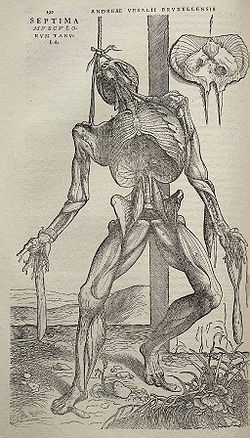
Jan Van Calcar
Encyclopedia

Netherlands
The Netherlands is a constituent country of the Kingdom of the Netherlands, located mainly in North-West Europe and with several islands in the Caribbean. Mainland Netherlands borders the North Sea to the north and west, Belgium to the south, and Germany to the east, and shares maritime borders...
-born Italian
Italy
Italy , officially the Italian Republic languages]] under the European Charter for Regional or Minority Languages. In each of these, Italy's official name is as follows:;;;;;;;;), is a unitary parliamentary republic in South-Central Europe. To the north it borders France, Switzerland, Austria and...
painter.
Life
Calcar was born in the Duchy of ClevesKleve
Kleve , is a town in the Lower Rhine region of northwestern Germany near the Dutch border and the River Rhine. From the 11th century onwards, Kleve was capital of a county and later a duchy...
(present day Germany
Germany
Germany , officially the Federal Republic of Germany , is a federal parliamentary republic in Europe. The country consists of 16 states while the capital and largest city is Berlin. Germany covers an area of 357,021 km2 and has a largely temperate seasonal climate...
) sometime between 1499 and 1510. Vasari refers to him several times, mainly with respect to his having been a pupil of Titian
Titian
Tiziano Vecelli or Tiziano Vecellio Tiziano Vecelli or Tiziano Vecellio Tiziano Vecelli or Tiziano Vecellio (c. 1488/1490 – 27 August 1576 better known as Titian was an Italian painter, the most important member of the 16th-century Venetian school. He was born in Pieve di Cadore, near...
. Calcar entered Titian's school in 1536 and was accepted to his faculty for his extraordinarily accurate copies of the works of that master. Calcar appears to have worked first at Dordrecht, but the greater part of his life was spent at Naples, and there, as Vasari tells us, "the fairest hopes had been conceived respecting his future progress".
Works
Giorgio VasariGiorgio Vasari
Giorgio Vasari was an Italian painter, writer, historian, and architect, who is famous today for his biographies of Italian artists, considered the ideological foundation of art-historical writing.-Biography:...
, Carel van Mander
Carel van Mander
Karel van Mander was a Flemish-born Dutch painter and poet, who is mainly remembered as a biographer of Netherlandish artists in his Schilder-boeck. As an artist he played an important role in Northern Mannerism in the Netherlands....
, and others credit Calcar with the eleven large woodcut
Woodcut
Woodcut—occasionally known as xylography—is a relief printing artistic technique in printmaking in which an image is carved into the surface of a block of wood, with the printing parts remaining level with the surface while the non-printing parts are removed, typically with gouges...
illustrations of anatomical studies which accompanied Andreas Vesalius's
Vesalius
Andreas Vesalius was a Flemish anatomist, physician, and author of one of the most influential books on human anatomy, De humani corporis fabrica . Vesalius is often referred to as the founder of modern human anatomy. Vesalius is the Latinized form of Andries van Wesel...
work on anatomy. The most notable among these is the anatomical study of the human body entitled De humani corporis fabrica libri septem or On the Fabric of the Human Body in Seven Books (1543).
Calcar is also said to have drawn the portraits of the artists in the early edition of Vasari's Lives. By some writers he has been declared to have been a close imitator of Giorgione
Giorgione
Giorgione was a Venetian painter of the High Renaissance in Venice, whose career was cut off by his death at a little over thirty. Giorgione is known for the elusive poetic quality of his work, though only about six surviving paintings are acknowledged for certain to be his work...
; all who write about him unite in stating that his imitations of the works of the great Venetian artists, and also of Raphael
Raphael
Raffaello Sanzio da Urbino , better known simply as Raphael, was an Italian painter and architect of the High Renaissance. His work is admired for its clarity of form and ease of composition and for its visual achievement of the Neoplatonic ideal of human grandeur...
, were so extraordinary that they deceived many critics of the day. His pictures are to be seen in Berlin, Paris, Florence, Vienna, and Prague, and his original works are, as a rule, portraits, although at Prague there is a remarkable "Nativity" by him, which was once the property of Rubens.
External links
- Jan Stefan van Calcar in the RKD

